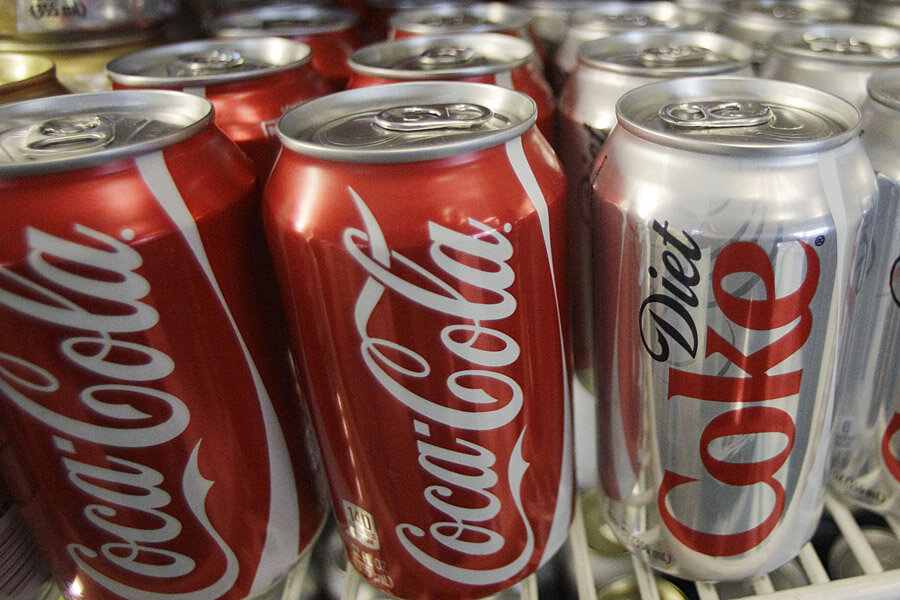Soda makers pledge to cut calories 20 percent by 2025. Too little, too late?
Loading...
In the face of falling sales, souring public opinion, and increased legislative scrutiny, the three largest soda companies in the United States have banded together to cut calories.
Coca-Cola, PepsiCo, and the Dr Pepper Snapple Group announced Tuesday that they will work to cut the calories Americans consume from sugary beverages 20 percent by 2025. The pledge was announced at the 10th annual Clinton Global Initiative, which is taking place in New York this week, and was made through a partnership between the Bill, Hillary & Chelsea Clinton Foundation and the American Beverage Association.
“I am excited about the potential of this voluntary commitment by the beverage industry,” President Bill Clinton said in a statement. “We look forward to continuing to work together to achieve the goals outlined in this commitment.”
To achieve the 20 percent cut, beverage companies will take a multi-pronged approach: for one, they say, they will leverage their marketing and distribution clout to steer consumers away from higher-calorie beverages to their other offerings, including “smaller portion sizes, water, and other no- or lower-calorie beverages,” according to a release from the American Beverage Association. “Through these efforts, water and other lower-calorie beverages are expected to grow significantly”
Second, each company will focus efforts in “communities where there has been less interest in and/or access to options that help consumers reduce their calories,” by changing how company vending machines, convenience store coolers, and fountain soda machines are stocked. Other possibilities outlined by the ABA include “product placement such as end aisle and checkout displays featuring only reduced-calorie beverages; merchandising efforts such as repositioning reduced-calorie beverages on shelves; providing coupons and other incentives promoting no/lower-calorie options; and taste tests/sampling programs in and out of store.”
Sugary soda consumption has been linked to obesity, which experts say has been particularly pronounced in low-income communities without easy access to fresh food from grocery stores and other sources. The Robert Wood Johnson Foundation, a public health nonprofit, applauded the soda companies’ pledge Tuesday: "We congratulate the Alliance for a Healthier Generation and the beverage industry for continued action towards reducing the beverage calories consumed by people across the United States,” the group said in a statement. “We are especially pleased that this commitment will target communities with disproportionately high consumption rates of sugar-sweetened beverages. We look forward to working with the Alliance and beverage industry to measure and monitor the impact of this commitment.”
The pledge comes as the soda industry faces a broad array of headwinds, both commercial and political. Soft drink sales fell 3 percent in the US last year, a continuation of a decades-long decline. In 1998, the average American drank about 56 gallons of soda per year; now, it’s approximately 42 gallons, according to Beverage Digest.
On the political end, soft drink companies have opposed several initiatives over the past few years that would tax soda consumption, including in San Francisco and Virginia. The latest initiative, in Berkeley, Calif., will be on the ballot in November. Last year, a ban on restaurants selling sugary drinks over 16 ounces in New York City was set to go into effect before it was struck down by a state Supreme Court justice. Critics, including Robert Reich, have compared the beverage industry’s tactics in defeating such measures to those of the tobacco industry years earlier.
In response to Tuesday’s announcement, Michael F. Jacobson, executive director of the Center for Science in the Public Interest, a Washington lobbying group, suggested that embracing such measures would more immediately effective.
“We applaud President Clinton for his efforts,” Mr. Jacobson said. “But we need much bigger and faster reductions to adequately protect the public’s health. The industry could accelerate progress by dropping its opposition to taxes and warning labels on sugar drinks.”








